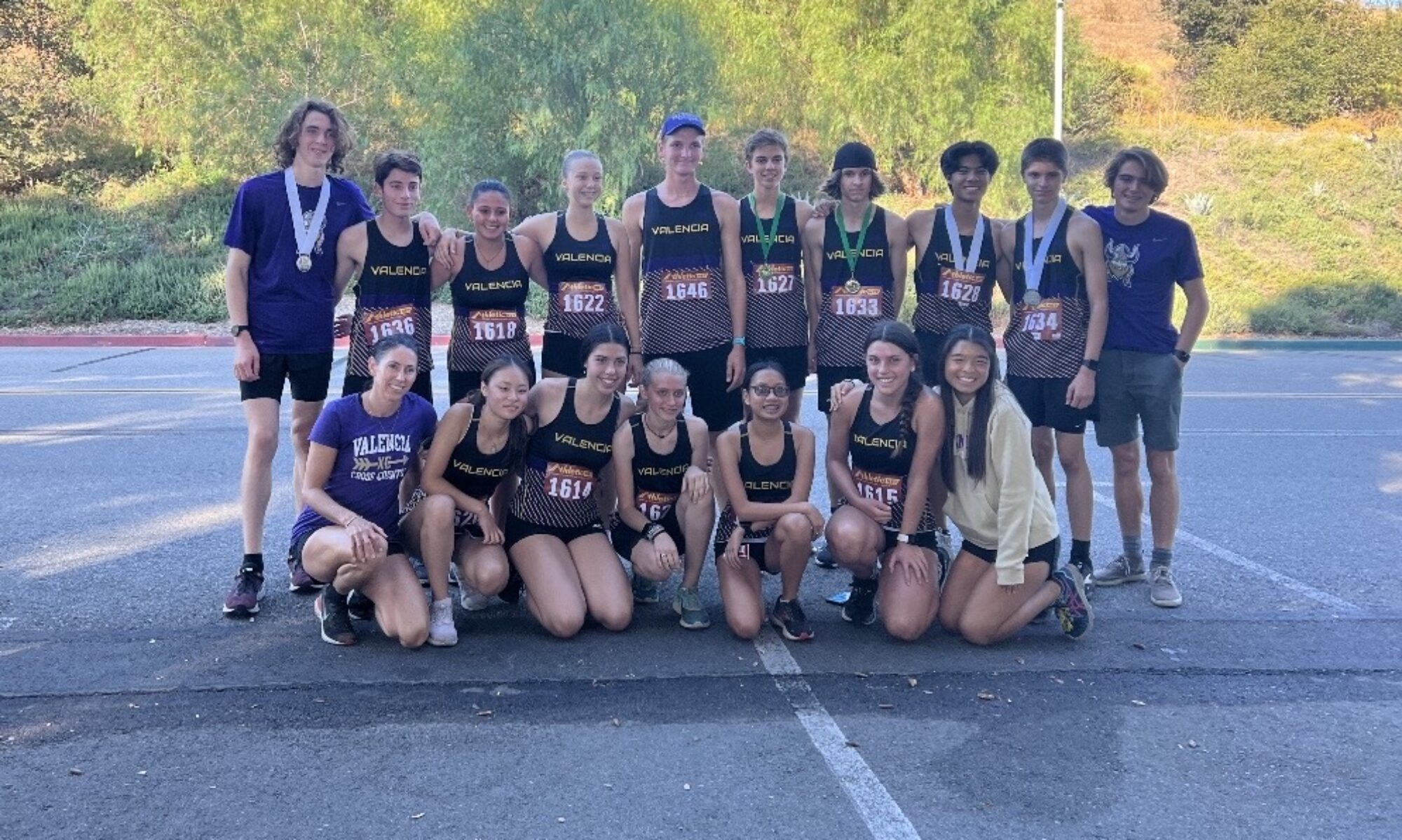Cross country is a team sport of long distance running. Practices and races are usually held on an open terrain consisting of woods, fields and hills. Terrains differ for each race.
Most of our high school races are 3.1 miles (5 km).
League:
Valencia High School (Valencia, CA – ((note: there is another Valencia High School in Placentia,CA)) participates in the Foothill League for cross country. Our (5) competitors in this league include Canyon, Golden Valley, Hart, Saugus and West Ranch.
Valencia High School is a Division 1 school by California Interscholastic Federation(CIF) Southern Section (CIF-SS) based on the overall student population of our high school. Our competitors compete in Division 2 because they are smaller schools. Although we participate against the Foothill League teams listed above during league season, during invitationals and post season competitions, we are most often seeded against other Division 1 schools.
Teams:
Girls and Boys run separately. In addition, Frosh/Soph, JV and Varsity run separately. Rarely a race may be combined in the event of weather, time constraints, low number of competitors, etc.
Frosh/Soph: Includes Freshman and Sophomores. Each high school may run as many runners as they like unless specific race/invitational rules define otherwise.
Junior Varsity: Includes Juniors and Seniors not running Varsity. Typically, but not always, JV events are open and allow more than seven runners unless specific race/invitational rules define otherwise.
Varsity: Competitions are run with maximum of seven athletes per team. Typically top seven runners. May be from any grade level. Coaches determine the Varsity runners. Coaches may change the Varsity runners race to race.
Scoring:
Cross country is different from most sports because the lowest score wins. The boys’ race is separate from the girls’ race. In addition, Frosh/Soph, JV and Varsity are run and scored independently.
For all teams, the places of the first five athletes on each team are added together to determine the team score. The sixth and seventh runners do not score but are valuable in displacing the other schools’ runners to a higher placing. In event a top five athlete(s) was injured, did not finish race, etc, and then the sixth and/or seventh runner would score for the team.
In event of a tie with another team, the sixth athletes’ places are compared to determine the winner.
It is important for the team to finish as close together as possible. For example, a finish of 1, 3, 4, 6 and 83 (a score of 97) will lose to a team finishing 16, 17, 19, 21and 23 (with a score of 96).
In event of what appears to be a tie between two runners crossing the finish line at the same time, the “winner” is the first runner’s torso to cross the line, not the feet. This sometimes becomes interesting in races where chips are worn on the runner’s feet since again the rule books say it is the torso that counts. For this reason, there are officials at the finish that make a ruling and sometimes photo finishes are also utilized.
League meets:
At each league meet, VHS competes against each school in the Foothill League. Our goal is always to finish first in our league. Our teams get points based on their overall placing at each league meet. These points are totaled up for the league meets and league finals. Example: 1st place team gets 1 point, 2nd place team gets 2 points, 3rd place team gets 3 points, 4th place team gets 4 points, 5th place team gets 5 points, 6th place gets 6 points.
Each league meet counts for single points.
A team’s placing at league finals counts double points.
Post-season:
Only Varsity teams are eligible to advance to the CIF Prelims. The top three overall high schools in the Foothill League advance to CIF prelims. This is determined at the conclusion of League Finals.
A 4th place team may also quality for CIF prelims if they are “ranked” in the top of their division by CIF, top 13 in two of the final four week rankings. To advance to CIF Finals, the team must finish in top four in their heat at CIF prelims if four heats, if three heats, top five per heat, plus sixth overall fastest among all heats.
To advance to state, the team must finish in the top 5-7 in their heat at CIF finals depending on division and season.
Link to California Interscholastic Federation – Southern Section website http://www.cifss.org.
What to bring to a cross country meet:
Running shoes, racing flats, socks, watch, water, racing tank and shorts, light and healthy snacks, depending on weather – sweatshirt, sweatpants, change of shoes/socks/clothes if it is raining.
Cross country terms:
Invitational meet – a multi team meet. Runners typically have to be “invited” to participate. Coaches will notify those that are running in our invitationals.
Top 7 – the scoring members of a cross country team.
Course – the marked and measured route of the race.
Starting Box – designated area to which a team is assigned on the starting line.
False start – leaving the starting line before the gun sounds.
Finish chute – a rope bordered funnel past the finish line that moves runners into their single file order of finish.
Pace – running speed over a particular distance.
Surge – a tactical increase in pace during the race.
Kick – a burst of speed at the finish of the race.
Pack – a group of runners in close proximity.
PR (personal record) – runnerss fastest race time for a specific distance and/or particular course.
Strides – gradual acceleration to a sprint then a deceleration.
Racing Flats – special, lightweight shoes designed for racing, rather than daily training.
Splits – the accumulated time at various intervals during a race (usually each mile) showing an athlete’s progress.
Hydration – Vital to ensure the athlete’s body has enough water to perform at his/her maximum potential.
Warm up – a running and stretching routine that gradually warms up the body for intense running.
Cool Down – a jogging/walking routine that allows the muscles to purge themselves of lactates.

